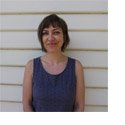
Every so often a writer comes along who reminds you of the immense possibilities of language.
Myfanwy Jones is that kind of writer.
The way she works with imagery. The way she structures her sentences. The way she creates characters who are real but slightly magical.
It’s just so… energising.
You can read in more detail my thoughts about Myfanwy’s latest novel, Leap, here. But please, allow me to introduce this fine Australian author.
Myfanwy started out subbing and writing restaurant reviews for a Saigon newspaper in the mid-1990s from which grew her debut novel The Rainy Season, shortlisted for The Melbourne Prize for Literature’s Best Writing Award. In 2009, she co-authored with Spiri Tsintziras the bestselling Parlour Games for Modern Families (Scribe, 2009), awarded Book of the Year for Older Children ABIA 2010.
Released this year, Leap is Myfanwy’s second novel
When you started writing ‘Leap’ what kind of story did you set out to tell?
At the risk of sounding evasive, there was no planning or even conscious intention with this novel. The first thing I knew Joe was opening his door to a strange girl and the rest came fast and hard – really, I just had to hold on for dear life. I would say now that I wanted to explore the creative, transmogrifying force of grief, juxtaposing vivid characters with a loose sense of reality, but I say this with hindsight.
There is certainly a blurring of reality in ‘Leap’, can you tell me why you decided to write in that way?
When we are mourning we very often want to blur reality and perhaps there is even something adaptive in this… perhaps some magical thinking, as Joan Didion called it, can be an integral part of the journey out of the woods. I think one of the central conundrums of grief is how to move forward without leaving the loved one behind. This problem might in the first place be paralysing but ultimately generates its own energy that can lead to all sorts of wild and beautiful possibilities.
The book contains some really beautiful and original imagery. What’s the secret to a good metaphor?
Metaphors do their best work when they are at once fresh and surprising while also immediately coherent and intuitive. No matter how lovely the imagery, if the reader doesn’t make the visceral connection the metaphor isn’t doing its job. It’s a tightrope (sorry, couldn’t resist).
One of the aspects I really enjoyed about ‘Leap’ was learning more about parkour, and tigers. How much research went into that aspect?
The first version was pure speculation but between drafts I spent several months doing research that felt for the most part like sheer indulgence. To embody my character Elise I went weekly to the zoo and sat with the tigers, trying to understand Elise’s relationship with the cats. I read about tigers, watched documentaries and spoke with a zookeeper who shared insights and anecdotes. For the parkour strand, as well as watching a huge amount of Youtube like my character Joe, and reading stuff, I was lucky enough to connect with a local stuntman and traceur who helped me to understand the parkour mindset and special way of seeing the world. He took me through lots of moves, too; even coming to the bridge to help me work out Joe’s final sequence. It was very hard work doing all this… no fun at all!
 Can you tell me about your writing process?
Can you tell me about your writing process?
While Leap was quick and surefooted, my first novel was long and laboured – five drafts at least and plenty of plans – so an entirely different process. I heard Michelle de Kretser say at a talk that you never really learn how to write novels, you only learn how to write the one you are working on. Next time you have to start all over. I fear this to be true. I can say that whatever I am working on, and this includes non-fiction projects like Parlour Games for Modern Families, I thrive on structure and deadlines and word counts. When I’m well into a draft I won’t call it a day until I’ve got my thousand words. I work best in the mornings and away from my house full of domestic traps. I’m lucky enough now to have a little writing room ten minutes away on High Street, Northcote.
What’s the best writing advice you’ve ever received?
To trust in not knowing what you are doing; indeed, to welcome the not-knowing like a vital, twisty little friend.
What are you working on now?
Right now I am fallow but not panicked… see answer above! It’s time to dig over and compost and plant seeds and see what comes up. In the meantime, I have the privilege of mentoring others with their writing projects and tending my actual garden bed. I am convinced broad beans were the inspiration behind Jack and the Beanstalk.
*For more information about Leap, or to purchase the book, visit Allen & Unwin

2 Comments
Karen Comer
Hi Cassie, I found your blog through Natasha Lester’s post. I’ve enjoyed looking around your site and reading your reviews. I write children’s novels and adult short stories and my reading swirls all around that! Look forward to following your blog.
cassandrahamer@hotmail.com
Hi Karen. The on-line writing community is pretty awesome so I’m glad we’ve found each other. Writing children’s novels and adult short stories sounds like a lovely combination where you get to flex a few different writing muscles. Cheers, Cassie
Comments are closed.